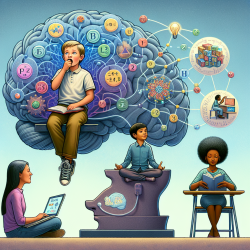Introduction
In the realm of speech-language pathology, creating effective interventions for children requires a deep understanding of various factors that influence outcomes. Recent research, such as the study titled "Evidence for sample selection effect and Hawthorne effect in behavioural HIV prevention trial among young women in a rural South African community," provides valuable insights that can be adapted to improve online therapy services for children. This blog explores how these effects can inform and enhance our practice, ensuring data-driven decisions lead to better outcomes for children.
Understanding the Research
The study conducted by Rosenberg et al. (2018) examined the influence of sample selection and Hawthorne effects in a behavioral HIV prevention trial. The research revealed that trial participants were more likely to remain in school than non-participants, indicating the presence of both sample selection and Hawthorne effects. These findings suggest that the participants' awareness of being observed and selected influenced their behavior, leading to higher school retention rates.
Applying Insights to Online Therapy
In the context of online therapy for children, understanding these effects can significantly enhance the effectiveness of interventions. Here’s how:
- Sample Selection Effect: Carefully selecting participants for online therapy can lead to more tailored and effective interventions. By understanding the characteristics of those who benefit most from online therapy, practitioners can design programs that cater specifically to these needs, ensuring better outcomes.
- Hawthorne Effect: The awareness of being observed can positively influence behavior. In online therapy, incorporating elements that remind children and their caregivers of the ongoing support and observation can enhance engagement and adherence to therapeutic activities.
Strategies for Practitioners
To leverage these insights, practitioners can consider the following strategies:
- Data-Driven Participant Selection: Use data analytics to identify children who are most likely to benefit from online therapy, ensuring resources are allocated effectively.
- Enhancing Engagement: Incorporate regular feedback and progress tracking to remind children and caregivers of the ongoing support, thereby enhancing motivation and engagement.
- Continuous Monitoring: Implement systems that allow for continuous observation and adjustment of therapy plans based on real-time data, ensuring interventions remain effective and responsive to the child’s needs.
Encouraging Further Research
While these strategies provide a foundation, further research is essential to refine and validate these approaches. Practitioners are encouraged to conduct studies that explore the impact of these effects in the context of online therapy, contributing to a growing body of evidence that supports best practices in speech-language pathology.
Conclusion
By understanding and applying the insights from the study on sample selection and Hawthorne effects, practitioners can enhance the effectiveness of online therapy services for children. These data-driven approaches not only improve outcomes but also contribute to a more efficient allocation of resources, ensuring that every child receives the support they need to thrive.
To read the original research paper, please follow this link: Evidence for sample selection effect and Hawthorne effect in behavioural HIV prevention trial among young women in a rural South African community.










